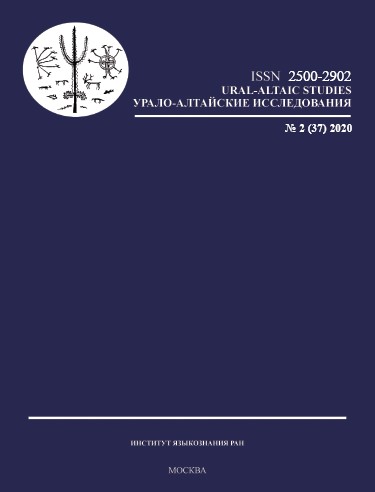Рефлексы праэвенкийского *s в говорах эвенкийского языка во второй половине XVIII в.
Reflections of the Proto-Evenki *s in the Evenki dialects in the second half of the 18th century
Author(s): Karina O. MishchenkovaSubject(s): Cultural history, Theoretical Linguistics, Phonetics / Phonology, Lexis, Historical Linguistics, 18th Century
Published by: Институт языкознания Российской академии наук
Keywords: Pallas; Sjögren; Evenki phonetics; Evenki dialect; Proto-Evenki; Tungusic languages;
Summary/Abstract: Tungusic lexical lists within “Comparative dictionaries of all languages and dialects” by P. S. Pallas (1773 year of recording, 1787—1789 years of edition) represent the earliest and most representative lexical material for the dialectology of the Evenki and Even languages. The lists contain vocabulary in seven Evenki and two Even dialects. The subject of considerable interest is also a manuscript of A. J. Sjögren (redrafted in 1842) that contains similar materials in six Evenki and two Even dialects and in Manchu. This article attempts to compare the vocabulary presented in the dictionaries of P. S. Pallas and A. J. Sjögren, to establish the time and place of its recording, as well as to clarify the distribution of the Evenki dialects in the second half of the 18th century. The study reveals that the manuscript of A. J. Sjögren most likely represents the revised and expanded vocabulary materials of P. S. Pallas excepting the list in the Evenki dialect of the Chapogir clan. The present study focuses primarily on the reflection of the Proto-Evenki *s as one of the differential phonetic features of the Evenki dialects. The data reflected in the dictionaries collected from the Evenki of Mangazeya, Yeniseysk and the Chapogirs allow to highlight the ʃ isogloss for the basin of the Yenisei River. The dialects spoken by the North Baikal Evenki of the Upper Angara River and the Transbaikal Evenki of Nerchinsk show the same hushing character. The vocabulary recorded from the Barguzin Evenki testifies the hissing character of the dialect in anlaut and mixed character (s and ʃ) in inlaut. In the dialect of the Nerchinsk Evenki in anlaut and inlaut there may be reflected s as well as ʃ. The dictionary of the Evenki dialect recorded on the territory of modern Yakutia demonstrates the ʃ reflection and isolated cases of s reflection in anlaut and the distribution of ʃ and h in inlaut.
Journal: Урало-алтайские исследования
- Issue Year: 2020
- Issue No: 02 (37)
- Page Range: 31-57
- Page Count: 27
- Language: Russian

